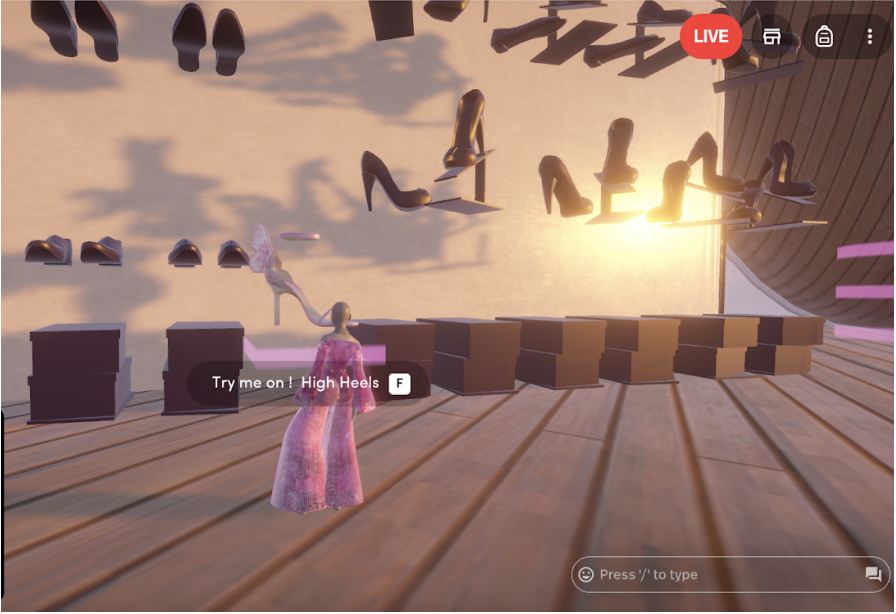
When digitalization first hit the fashion world in 2020, few took the buzz seriously. Pixel clothes were similar to the costumes of 2000-s game characters, NFTs were associated solely with complex technology, and augmented reality technology was far from reality itself. Today, the words digital, metaverse and NFT are becoming completely inevitable, penetrating the consciousness of almost every consumer and the marketing strategies of almost every brand. Whether it’s the regular releases of non-fungible tokens, the launch of virtual marketplaces, or the emergence of virtual influencers, the world of digital fashion is growing, setting an exciting precedent for what could happen in the future.
This spring, the phenomenon of virtual events is becoming increasingly evident: several digital fashion weeks took place simultaneously with the real fashion week season in Paris, New York and Milan. In the latter, Digital Fashion Week completed its fourth edition. This time, Limitless Innovation, Nolu Factory and HGVIS united to showcase the latest innovations in Phygital — AI, AR, VR, NFTs and NFCs.
Fewer purchase returns and increased sales conversion
Imagine being able to try on any item in the world without visiting a store. I’ve seen many examples where real-life products appear unrealistic or absurd, affecting the first impression about the brand. This is what my experience with Ikea Studio was, as I found some furniture pieces looking cartoonish and poorly designed, failing to meet my expectations, so I had to visit a shop to see the real item.
However, objects can be vivid and realistic — the OuttaWRLD app is a case in point. The company enables customers to immerse themselves in brand products, offering cutting-edge virtual try-ons, real-time customization of different colorways, and compelling brand storytelling.
Its creator, Charles Wilders, demonstrated how realistic a product a user can see before purchasing. The example of Ikea illustrates the importance of accurately conveying not only the size but also the nuances of shades, textures and shadows. Back home, I tried to verify this by downloading the application, which projected a virtual T-shirt that looked incredibly realistic in my room.
In the case of clothing, a great precision in rendering is crucial; being able to see all the details, cuts and quality, as well as having the opportunity to try it on oneself, is particularly significant for the younger generation. Recent data suggests that 70% of younger consumers are seeking more immersive, engaging and experiential interactions with their favorite products.
Looking at this, I thought it would be cool to digitize all the dresses I’ve ever seen in films or magazines and would like to find, but now they will forever remain only in memory. With the help of AI technology, you can find on the Internet anything you see in a movie, on the street or in a magazine. To do this, you just need to have a screenshot, said software company Unleash The Dragon co-founder Andreas Anding. The company managed to reduce the number of items returned after purchase by using a method of accurately transferring any clothes onto a user’s photo, which takes into account all of their physical characteristics.
4D Scanning Brings Extreme Reality To Virtual Clothes
“The ability to create virtual collections faithful to reality at 95%, allows you to check the satisfaction of consumers in advance, solving the problem of advance purchases and the production of useless samples, which constitute the highest cost and waste for a clothing company,” believes Barbara Fontana Ozawa, founder of Eretikosiki, a company that brings physical wardrobes into virtual worlds.

Eretikosiki CEO Barbara Fontana Ozawa and her digital works.
With offices in Milan and Tokyo, Eretikosiki collaborates with famous fashion brands, not only creating collections, but also holding real fashion shows in virtual reality. Barbara’s digital work is striking in its combination of taste, imagination, and at the same time realism, which is achieved through the use of 4D body scanners to create avatars based on the morphological characteristics and measurements of clients’ models.
Looking at the dresses transferred by Barbara using scanning, you are amazed at how realistically the texture, elements and fit are conveyed with every movement of the digital avatar. Interestingly, it was Barbara who created the breathtaking background animation for the Digital Fashion Symposium Milan.

Digital Fashion Symposium Milan Conference
Forgot your wallet? Pay for coffee with a jacket
The beauty of new technologies is that their integration with physical objects can take any form. What if I told you that you can integrate any gadget or information into your jacket — for example, a phone, a passport or an e-wallet? At the Digital Fashion Symposium Milan, Digiseq spoke about its recent collaboration with Hugo Boss for the Hahnenkamm Races, which took place January 15-21, 2024, in Austria. Visitors who purchased a jacket from ski jacket from the latest BOSS x Perfect Moment capsule collection could transform it into a smart device thanks to a custom tag on the sleeve containing various technologies that were personalized to the individual wearer’s needs for the weekend. With a single tap of their jacket sleeve, customers could access the race, slopes and shops, and even make contactless payments. It was interesting to learn that the potential of such technology is estimated at hundreds of millions of dollars. Analysts predict that the wearable tech market will surpass half a trillion dollars by 2032. The main thing is to work on issues of data security and protection from accidental activations and theft.

BOSS x Perfect Moment ski jacket with NFC wallet on a sleeve
Fashion Metaverse Conference and virtual runways
After the DFW Symposium Milan conference, we had the opportunity to experience a virtual event by attending the Fashion Metaverse Conference (#FMC24) organized by Yiqin (Isola) Zhu, the founder of the digital fashion platform HGVIS. The event took place in Spatial, one of the leading competitors of Roblox, featuring nine thematic spaces designed by metaverse figures such as IRA X LAB and Dr. Martha Boeckenfeld, an award-winning Web3 influencer.
From March 26th to 30th, participants could interact with others, enjoy games, collect wearables, try on clothing and listen to presentations from over 70 experts in the fields of fashion, technology, AI and Web3.
I want to say that the virtual experience is worth trying at least because it requires less time and energy. Before an offline event, you have to gather, prepare business cards, and travel to the location, often in another country. Meanwhile, with Spatial, you just need a couple of clicks to upload your avatar and enter the room. Still, even if it’s remote, people are going to be late for some speeches (me not being the exception), which is why it was so hilarious watching avatars literally running to the venue entrance once arriving at the shore of the Shmerz theatre.
Created by Marzio Camasso, an artist and a VR designer, known otherwise as Shmerz, Movie Theater was a central place of the conference with a seating capacity of 220, where attendees were listening to the speeches by web3 industry leaders.

Marco Pizzini speaking at the Fashion Metaverse Conference
One of the most significant insights from the conference speeches centers around the strong connection between the on-chain and off-chain dimensions of Web3 communities, and the evolving landscape of digital fashion seamlessly bridging the physical and virtual realms. This transformation profoundly impacts our understanding of identity, style, and community dynamics. Specifically, various emerging projects shared compelling use cases and insights into virtual clothing production, metaverse design, consumer experiences, and sales strategies.
Among others, digital creator platforms like LIVVIUM and Phygital Twin showcased their role in assisting fashion designers in creating and marketing digital clothing. Through experimentation with digital prototypes, these platforms help minimize the reliance on physical samples, thereby reducing waste in the fashion industry.
On the other hand, VR technology, as evidenced by events like FMC24, democratizes access to such gatherings, allowing individuals from any corner of the globe with an internet connection to participate and engage with fellow Web3 enthusiasts. Attendees can personalize their avatars with the latest fashion trends from the off-chain world, enhancing their virtual presence. Marco Pizzini, CEO of the AR project Metagate, demonstrated the potential of augmented reality in urban spaces, showcasing applications ranging from virtual runways and concerts to promotional events and guided tours.
After the conference, it was possible to do virtual fittings in the glamorous pink Chic Shop from PinkCryptoBabe, a prominent Spatial influencer. The designer placed stands with his own collection of dresses and suits, some of which you could not only try on, but also keep for yourself.

Chic Shop where you can try virtual collection by CryptoPinkBabe
Overall, it’s thrilling to witness the emergence of more talented individuals and innovative use cases at the intersection of technology and fashion. We can no longer deny how deeply cryptocurrencies, AI, and AR/VR are already integrated in our lives. The positive experiences from these projects we see dispel fears of new technologies and inspire each person to choose their own way of interacting with them.
By merging the digital and physical realms of fashion, they present fresh and enticing opportunities for consumers, designers and brands alike. These technologies hold the promise of reshaping our perceptions, consumption habits and interactions with fashion, fostering a more sustainable and captivating fashion industry.
AR and VR technologies are pivotal in bridging the gap between the metaverse and physical reality. VR allows users to immerse themselves in entirely digital environments, while AR overlays virtual elements onto the real world. Both of these technologies enhance user experiences and facilitate the integration of metaverse fashion into everyday life.
The views and opinions expressed herein are the views and opinions of the author and do not necessarily reflect those of Nasdaq, Inc.


